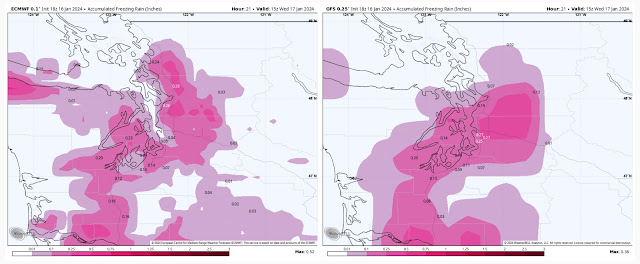FastCast--Tuesday, Jan. 30 to Saturday, Feb. 3:
Record high temperatures have occurred across the Pacific Northwest over the past couple days, as the region lies in the warm sector to the south of an atmospheric river impacting British Columbia. This has brought highs in the upper 50s to mid 60s to Western Washington, something that will continue over the next couple days. On Tuesday, expect mostly cloudy conditions with highs in the upper 50s to low 60s, lows in the upper 40s to low 50s, and a chance of morning showers. Rain is expected across the region from Wednesday to Thursday, totaling around 0.25-0.75", more north of Seattle. On Wednesday and Thursday, expect highs in the mid to upper 50s, with lows in the mid 40s to low 50s. Rain will taper off by midday Thursday, and a dry start to February is expected. Friday will be partly cloudy, with highs in the low 50s and lows in the low 40s. Saturday will also be partly cloudy, with temperatures dropping further to highs in the mid to upper 40s and lows in the mid 30s. In the mountains, expect snow levels to remain above 6,000 feet through Wednesday night, before dropping to 3,000 feet by Friday. However, little (if any) snow will fall at the passes.
---------------------------------------------------------
Continue reading the full blog below!
An unseasonably warm few days will continue for the Pacific Northwest, as the region is stuck in the warm sector to the south of a strong atmospheric river impacting British Columbia. Let's take a look at the forecast!
First, the European model forecast for highs on Tuesday, seen below.
This forecast shows highs in Western Washington in the upper 50s to low 60s, with the coast reaching similar temperatures, and the Willamette Valley/Oregon Coast reaching the upper 50s to mid 60s. Eastern Washington reaches the low 40s to mid 50s, warmest in the Palouse region.
Let's compare this to the NAM high-resolution forecast for highs on Tuesday, seen below.
This forecast is much warmer, showing Western Washington reaching the upper 50s to mid 60s, warmest around Bellingham and from Seattle to Olympia, especially in SE King County and E. Pierce County, due to downsloping SE winds. This forecast shows highs in the mid 50s to mid 60s for Western Oregon, and highs in the mid 40s to mid 50s in Eastern WA (again, warmest in the Palouse region).
The next round of rain is also ahead for the region. There is a chance of showers from late Monday night into Tuesday morning, but most of the rain will fall from Wednesday morning to early Thursday morning.
Below is the European model forecast for total rain through Thursday.
This forecast shows 2 rain shadows in the lowlands, a broad area of 0.1-0.2" of rain from Everett to the Canadian border, and an area of 0.15-0.25" of rain from Olympia to Enumclaw. The rest of the lowlands should pick up 0.25-0.5", except up to 0.8" on the Kitsap Peninsula. The coast will receive 0.5-1.25", most north of Ocean Shores. Expect 0.75-1.25" in the Cascades and 2-3" in the Olympics, with 0.05-0.3" in Eastern WA (more possible in mountains).
Let's compare this to the GFS forecast, also showing total rain through Thursday, seen below.
This shows a mostly similar forecast, with a rain shadow from Port Angeles to Skagit County (0.15-0.25" in this area). The remainder of the lowlands will receive 0.3-0.6" in this forecast, except up to 1" on the Kitsap Peninsula. The coast will get 0.5-1", except 0.3-0.4" south of Ocean Shores. This forecast shows 0.1-0.4" for most of Eastern WA, except up to 0.6-0.9" for the eastern slopes of the Cascades. Additionally, this forecast shows 0.5-1.5" in the Cascades and 2-4" in the Olympics.
Finally, let's take a look at the upcoming temperature drop, as we slowly return to seasonable temperatures across the region.
Below is the European Ensemble forecast for highs and lows in Seattle.
Expect relative warmth to continue through Thursday, before highs plummet to the 40s to low 50s, with lows dropping to the mid 30s by the weekend.
Let's also take a look at the forecast for temperatures in Spokane, seen below.
This forecast shows "warmer" temperatures continuing through midweek, before dropping off by the weekend. Lows will remain in the 30s for the duration of this forecast.
Enjoy the spring-like warmth through Thursday, as we won't encounter similar temperatures for awhile!




















































